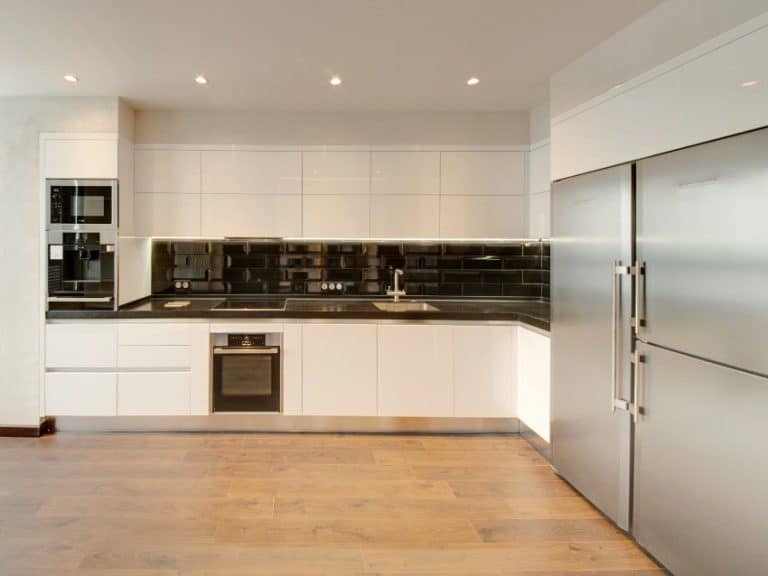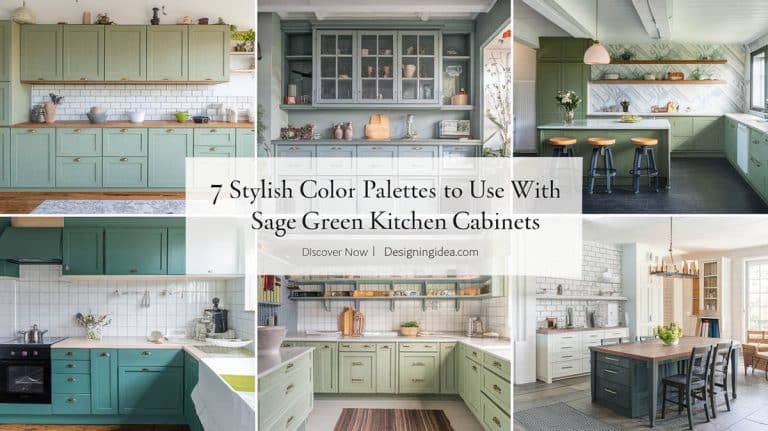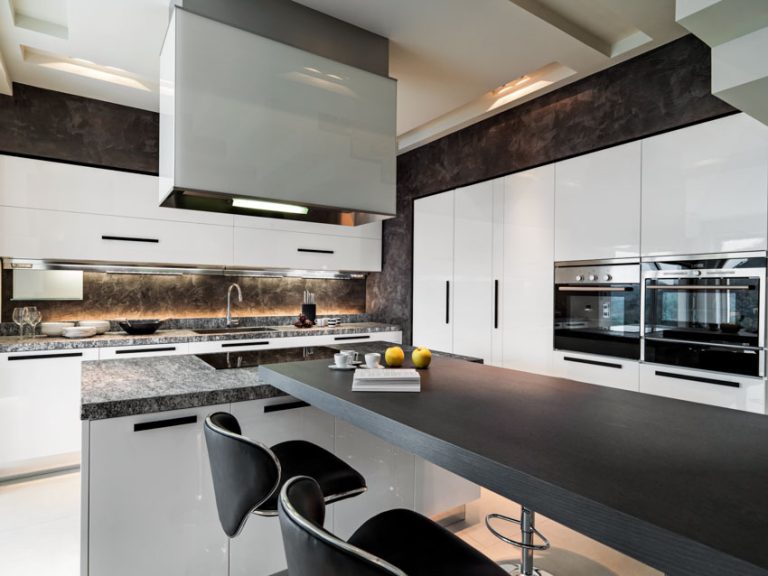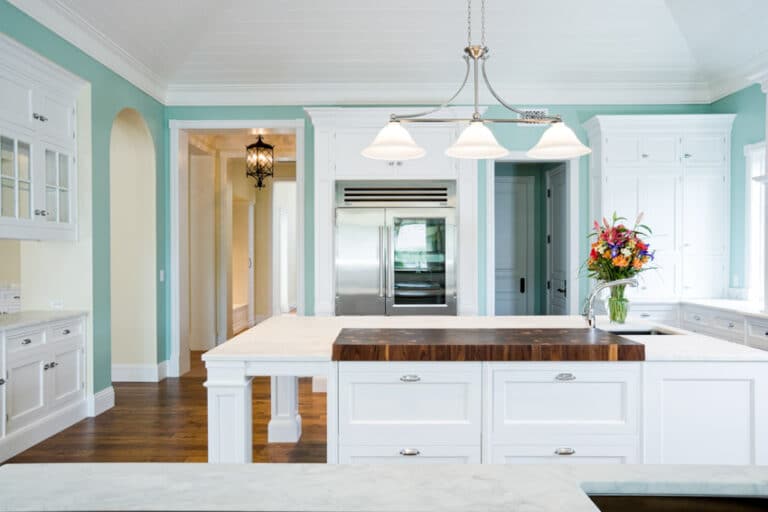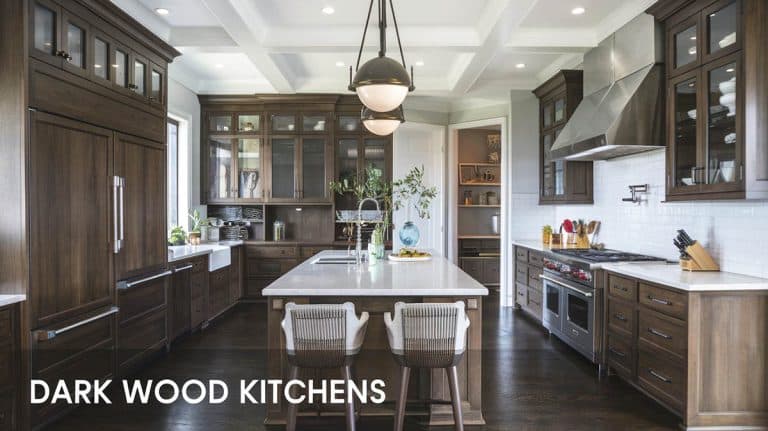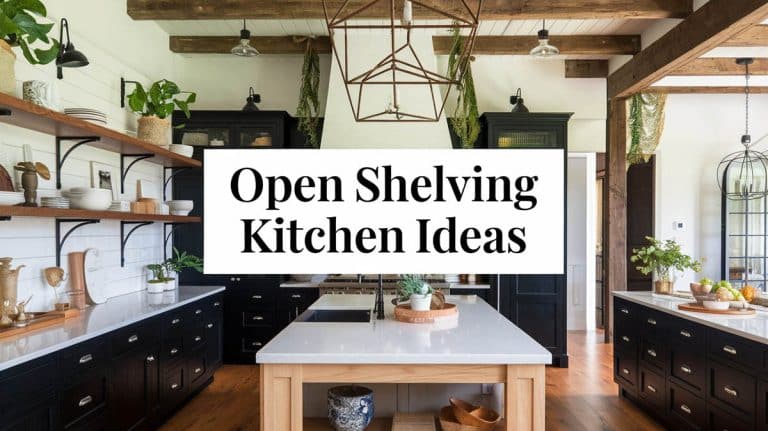10 Color Combinations That Go With Turquoise Kitchen Cabinets

Adding a pop of color to your kitchen can be tricky, but turquoise cabinets have the power to take your space from bland to grand. When paired thoughtfully, that striking aqua hue makes an undeniably eye-catching statement. The key is choosing the right supporting cast to let the turquoise shine. We’ll explore foolproof color combinations, materials, and design details that complement – rather than compete with – your daring turquoise kitchen cabinets.
(Images generated using AI to showcase potential design ideas.)White and Turquoise: Creating Timeless Elegance
The timeless color pairing of white and turquoise leverages a core design principle – neutral white allows the vibrant hue to shine.
For walls, go pure white with Benjamin Moore’s “White Dove” or “Chantilly Lace” in modern spaces. In traditional settings, warmer whites like Sherwin-Williams’ “Alabaster” or “Greek Villa” add a classic flair. Consider a subtle pearl finish for dimensional interest.
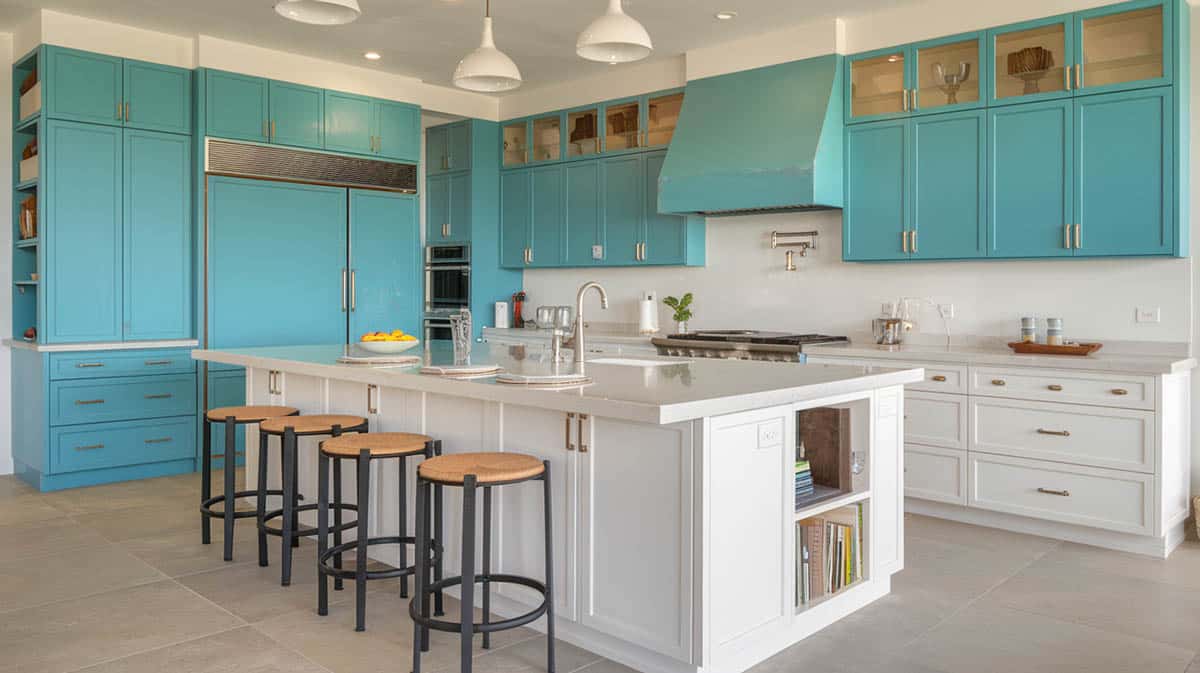
Backsplash possibilities are endless. Classic subway tiles laid in varied patterns (herringbone, stacked, running bond) offer textural contrast. Handmade ceramic tiles provide organic shapes. While marble with faint veining elicits natural movement.
To take this combination to the next level, layer multiple whites through varied textures. Incorporate metallics, scaling up sizes from small hardware to large lighting fixtures. High-gloss white elements expand spaces by reflecting light. When selecting metals, consistency is key – pair either warm metals like brass and gold or cool metals like chrome and nickel for a cohesive finish. This attention to detail enables white and turquoise to create truly timeless elegance.
Gray and Turquoise: Sophisticated Depth
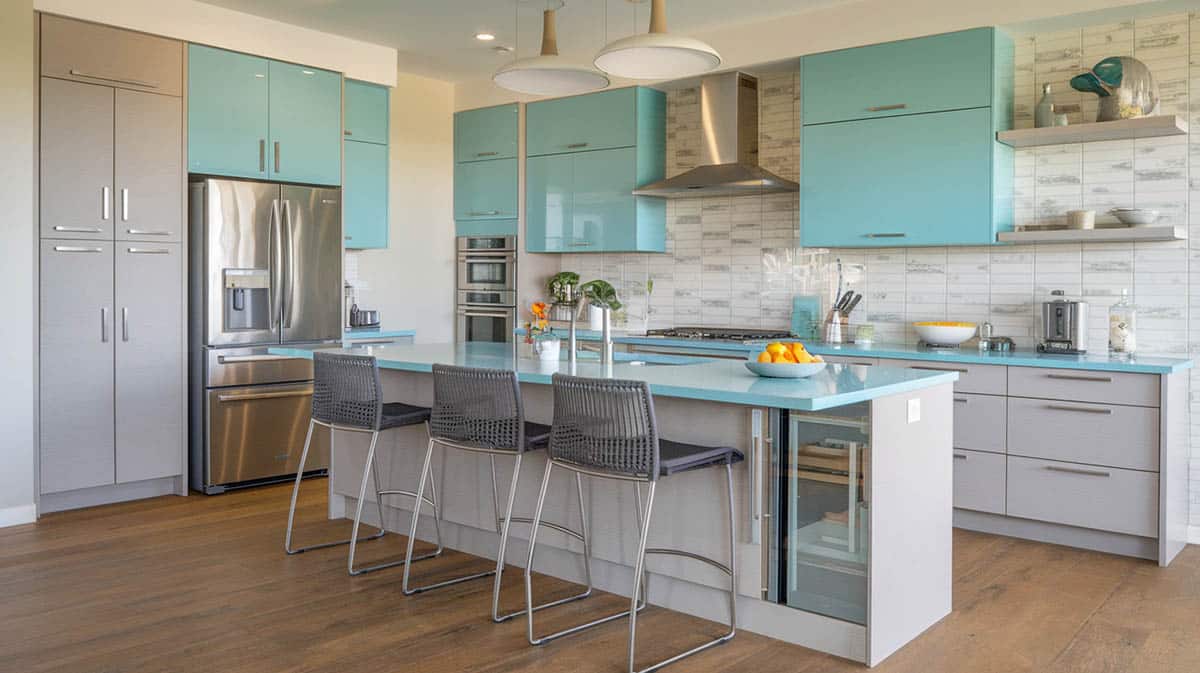
When paired together, gray paint and turquoise cabinets make for a surprisingly sophisticated combo. The soft neutrals of light grays provide a subtle and spacious backdrop, while pops of aqua blue cabinetry add an unexpected punch of drama. It’s all about creating visual depth through strategic contrast.
Choose a light, airy gray, like Sherwin-Williams’ “Repose Gray” for the walls. Not too cold, not too warm – it’s a perfect neutral that lets the bolder hue take the spotlight. Then have fun with your cabinet and trim selections by looking at porcelain tiles with cool concrete-style finishes or experimenting with different natural stones that pick up on the blue and gray tones.
Don’t be afraid to layer in multiple shades of gray throughout the space either. Use a mid-tone gray like Benjamin Moore’s “Coventry Gray” on an accent wall or select a dark charcoal gray like Farrow & Ball’s “Down Pipe” for trims and doors. Playing with varied finishes like glossy paint, textured wallpaper, or decorative tiles keeps things interesting too.
Wood Tones and Turquoise: Natural Harmony
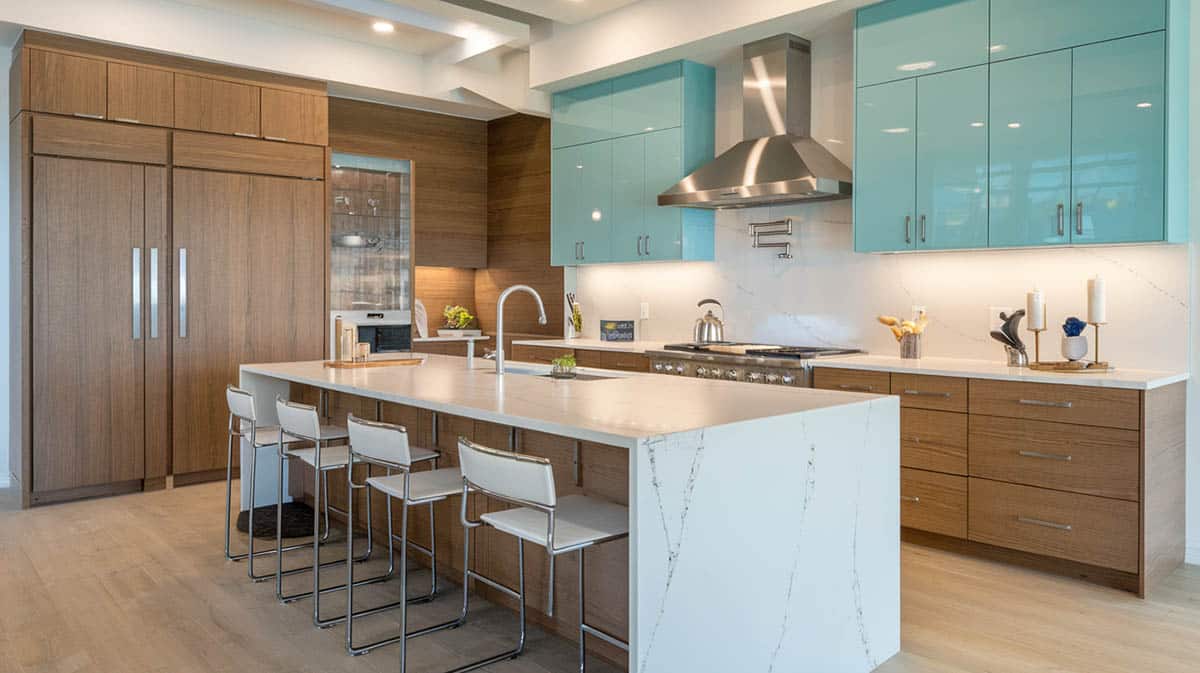
When designing with turquoise cabinets, the key is achieving harmony between the cool tones and warmth of natural wood elements. I like to think of it as an artful balance between land and sea. The wood you select sets the aesthetic tone. Light oak has an airy, Scandinavian feel that pairs nicely with pale turquoises. White oak offers clean modern lines contrasting bolder aqua shades. Walnut adds a rich, traditional warmth that works well with jewel-toned hues. And for real dramatic flair, try mahogany’s striking ruddy tones against paler turquoises.
How you implement the wood also impacts the look and feel. Wide-plank floors create a spacious backdrop for your cabinets to shine. Classic herringbone patterns interplay with the linear cabinet fronts for timeless elegance. Or go for casually sophisticated by mixing wide and narrow boards underneath.
When layering wood elements, vary the grain patterns and tones within a controlled range for lots of visual interest. Incorporate wood vertically on walls or ceilings and horizontally underfoot. The mixing of natural wood warmth against the cool pop of turquoise makes for a beautifully inviting kitchen.
Navy Blue and Turquoise: Advanced Color Layering
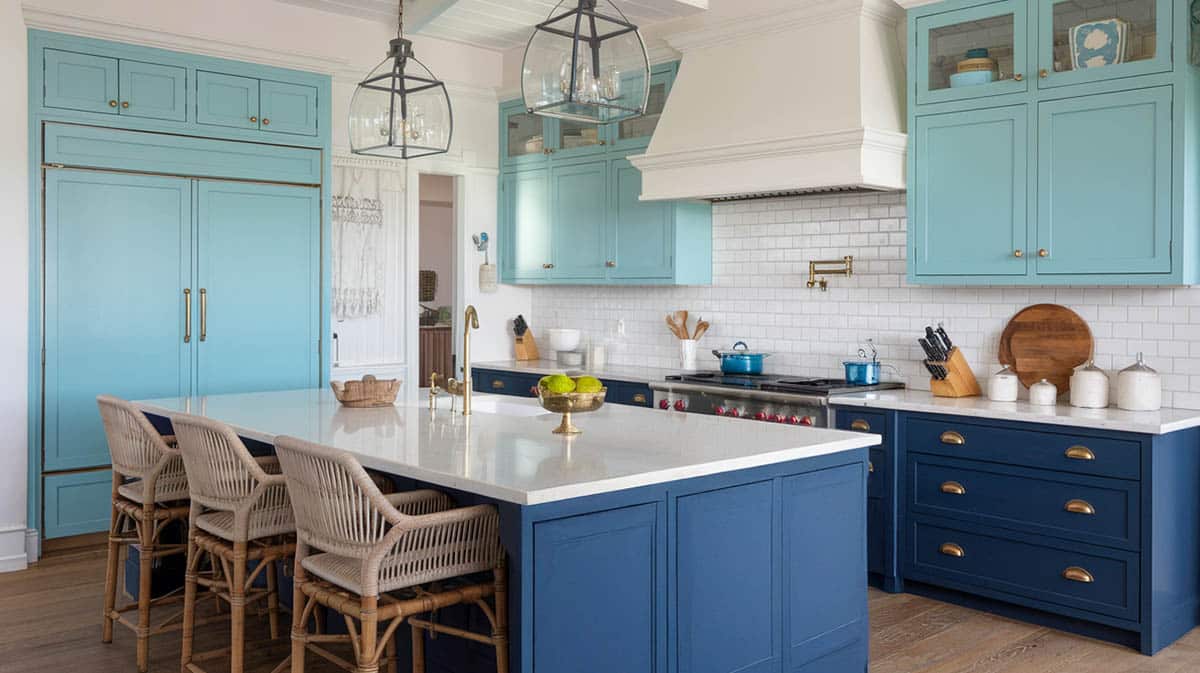
When working with a navy and turquoise color scheme for your kitchen cabinets, strategic color layering is key to creating depth and interest. I love using Benjamin Moore’s rich “Hale Navy” blue as an accent wall to anchor the space – the dark hue draws the eye while allowing the aqua-toned cabinets to pop. For extra dimension, consider incorporating some navy vertical elements like open shelving or tongue-and-groove millwork to play with height. Navy also works beautifully when integrated as a subtle texture through wallcoverings with dimensional patterns – this adds depth without overwhelming the senses.
When it comes to patterns, there is so much room for creativity by layering navy and turquoise! Geometric combinations framed with a thick navy outline interspersed with softer turquoise shapes make for fun backsplashes. For a coastal vibe, maritime motifs like waves, anchors and ropes are a seamless fit. Or go for totally unique designs with abstract shapes and lines that artfully incorporate both tones. Varying the scale from small mosaic tiles to extra-large statement tiles allows you to define specific areas while tying everything together.
Don’t forget the hardware! Warm brass knobs and pulls add a welcome touch of shine to break up all the blue. Polished nickel creates a more upscale, reflective surface. And matte black hardware punctuates the scheme with contemporary contrast.
Gold and Turquoise: Luxurious Contrast Creation
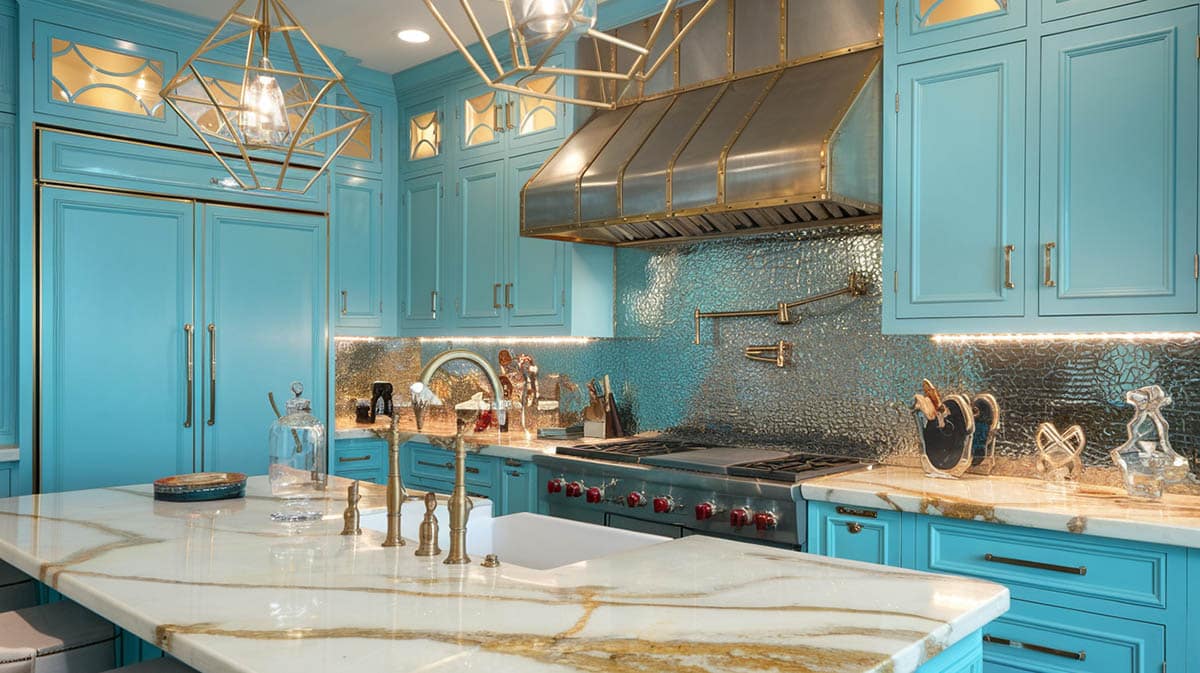
Looking to add some excitement to your design? Consider playing with a bold color contrast between gold and turquoise cabinets. The inherent warmth of gold plays beautifully against the cool tones of the cabinetry. It’s an eye-catching combo that is sure to impress your guests. When selecting hardware, opt for 3-8 inch brass cabinet pulls for maximum visual impact. Exposed brass hinges will carry the brass details onto the doors themselves. And don’t forget the faucet – look for a statement-making brushed or polished brass fixture to tie the whole look together.
Strategic lighting can enhance the contrast even further. Hang geometric brass pendants over the center work area for a punch of shine. Under-cabinet brass lighting strips will provide handy task lighting while contributing to the glam vibe. Brass wall sconces make excellent accent lighting as well. To take the look over the top, consider adding more metallic and brass details throughout the space. Gold-veined countertops, metallic backsplash tiles, and brass trim pieces will make the cabinets the glittering centerpiece of your gorgeous new kitchen.
Black and Turquoise: Contemporary Drama

When it comes to kitchen design, few color combinations pack as much visual punch as pairing bold black cabinets with vibrant turquoise accents. This high-contrast look makes a dramatic statement, but getting the balance right is key to maintaining harmony. Used thoughtfully, this scheme creates an ultra-modern kitchen with sophisticated style. Black countertops of honed granite or quartz anchor the space, complemented by matte black hardware and appliances for a streamlined look. Incorporating glossy black backsplash tiles, mirrors and metallic accents makes the dark cabinetry shine, literally reflecting light around the room.
The vital counterpoint to all this inky drama is the energizing pop of turquoise. Splashing this vibrant hue onto walls or island units prevents the scheme from feeling too heavy. Geometric patterns in black and white with occasional turquoise accents marry the two tones, as do abstract designs that riff on the colors at varied scales for visual interest. It’s a bold backdrop for entertaining!
Yellow and Turquoise: Energetic Harmony

The vibrant yet soothing combination of yellow and turquoise cabinetry brings an energetic harmony to any kitchen. This adjacent pairing of complementary colors creates a visually striking look that remains comfortable on the eyes. When using yellow cabinets, go for cheerful, sunshine-evoking shades like Benjamin Moore’s “Yellow Happiness” or Sherwin-Williams’ soft “Butter Up.” Creamy yellows like Farrow & Ball’s “Hay” also keep things warm and bright. Use these lighter yellows to coat the main kitchen walls for an ambient glow.
Then make a bold statement by showcasing deeper, attention-grabbing yellows on focal walls or architectural details. Vibrant turquoise cabinets will pop against this sunny backdrop. For maximum impact, display open shelving to exhibit stacks of turquoise dinnerware. Yellow and turquoise dish towels or other decorative elements hanging from the oven handle inject more zing!
Cream and Turquoise: Sophisticated Warmth
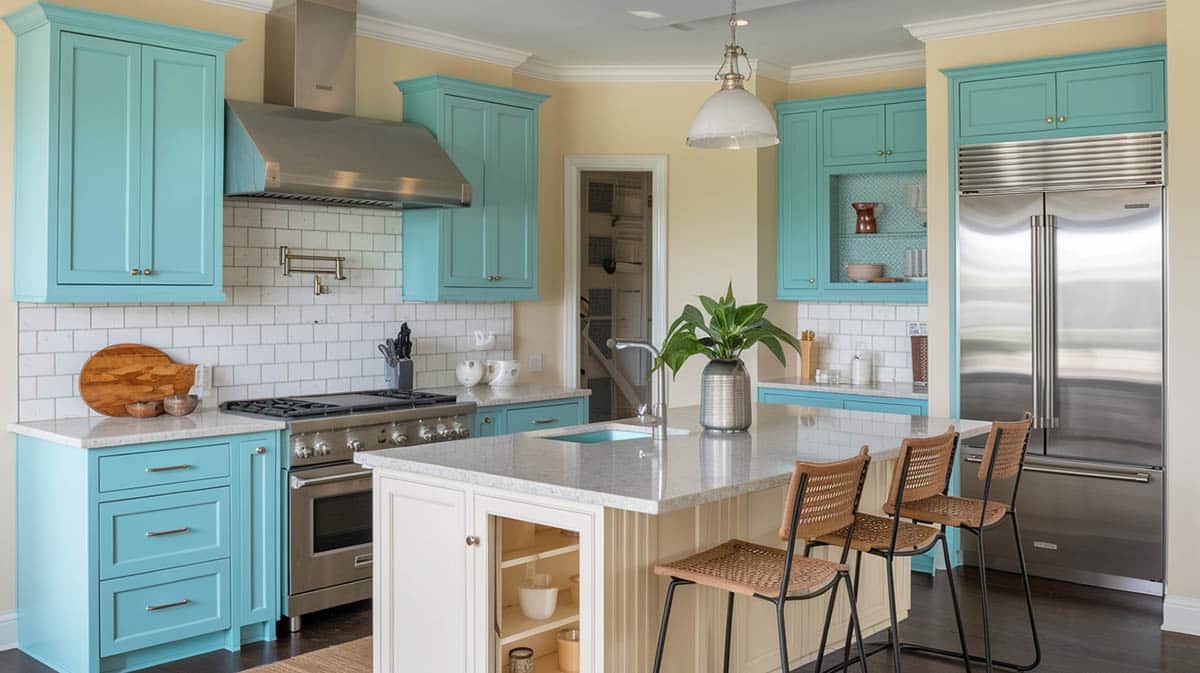
Cream and turquoise is an elegant color combination that brings together warm, welcoming cream tones with cool, sophisticated turquoise accents. The result is a beautifully balanced kitchen that feels both cozy and refined. When selecting wall colors, go for rich, warm hues like Benjamin Moore’s popular “Swiss Coffee” or Sherwin-Williams’ creamy white “Creamy.” For a dramatic look, there’s also Farrow & Ball’s deeper “Pointing.” Pair these cream walls with a handmade ceramic tile backsplash in soothing turquoise tones for lovely texture and depth. Subtle variations in the tile glazes prevent uniform perfection for an organic, approachable feel.
Focus on varying textures even within a single material to add visual interest. Creamy matte finish paint keeps the walls soft and inviting, while pearl-finish trim and glossy cream ceramic tile accents add dimension. Weave in natural materials like rattan light fixtures, linen curtains, jute rugs and woven upholstery to complement the textures and tie everything together.
Coral and Turquoise: Dynamic Complementary Harmony
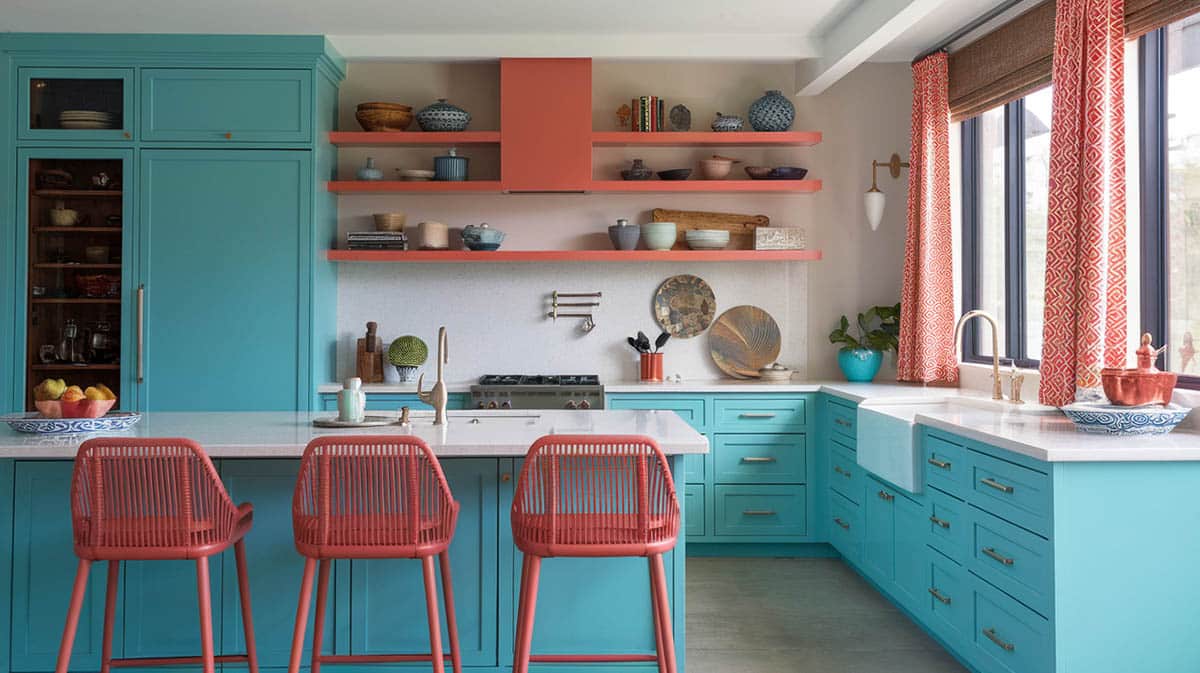
When designing a kitchen, complementing coral accents with turquoise cabinets creates an elegant and sophisticated color palette. The lively coral introduces warmth, while the cooling turquoise brings depth. Though opposite on the color wheel, together they produce a harmonious balance when carefully used.
Strategically, the turquoise should act as the dominant color, making up 70% of the scheme in the cabinetry itself. Neutrals like white and beige offer a subtle backdrop, covering about 20% of the space. Vibrant coral accents sprinkle throughout the remaining 10% area, drawing the eye to key focal points. Consider coral bar stools to surround a kitchen island, textured coral window treatments to frame views, and artisan ceramic pieces displaying organic coral tones.
In terms of patterns, vary the scales dynamically. Pair large-scale floral coral prints with medium-sized geometric designs and subtle textural elements like woven baskets and ceramic knobs. The mix of coral and turquoise patterns in an assortment of sizes creates visual rhythm.
Bronze and Turquoise: Metallic Sophistication

When it comes to kitchen design, the combination of bronze and turquoise cabinets creates a richness and depth that feels both sophisticated and timeless. Rather than going for a trendy mint tone, the slightly deeper turquoise adds a subtle punch of color that balances beautifully against the warm, metallic bronze accents.
The key to making this aesthetic work is all about thoughtful distribution – keeping the turquoise as the dominant cabinet color for visual weight, while using bronze hardware, fixtures and backsplashes to add visual interest and textural contrast. You can make the bronze elements the bold statement pieces, like a dramatic antiqued range hood or elegant oil-rubbed bronze pendant lights over the island. Or take a more delicate approach with small metallic bronze tiles or cabinet pulls that blend more subtly into the design.
When using different finishes, a high-gloss turquoise island catches the light, adding modern flair against the matte sophistication of the perimeter cabinets. And don’t be afraid to consider mixing up surface textures – combine the smooth fronts of the bright cabinets with hammered bronze backsplash tiles and textured hardware for depth.
How To Get The Correct Color Combination?
Creating a vibrant turquoise kitchen requires thoughtfully balancing bold drama with timeless sophistication. This color cabinetry can anchor the space when strategically paired with crisp whites, warm bronzes or natural woods, complementing styles from Coastal Contemporary to Art Deco Modern. Since the bright hue can be overpowering, its often recommended to use a two-tone cabinet approach and pair the shade with a more neutral tone like white, cream or light gray.
Key Color Pairings:
White: Creates a timeless elegance
Bronze: Adds metallic sophistication
Wood: Introduces a natural warmth
Black: Delivers contemporary drama
Gray: Provides refined depth
Navy: Enables tone layering
Coral: Brings a dynamic energy
Gold: Infuses the design with luxury
Yellow: Adds a vibrant warmth
The secret is to use deliberate color balance. The 60-30-10 rule ensures visual harmony – 60% neutral backdrop, then 30% turquoise as a focal point, with 10% metallic or wood accents. Cabinet coverage also impacts visual weight, with 30-40% turquoise creating a balanced look, 50-60% for drama, or 20-30% for subtle accents.
Strategic material matching enhance turquoise’s depth and dimension beautifully. Combined with thoughtful lighting design to illuminate the rich cabinet finishes, these kitchens become stunning showpieces. North-facing rooms suit brighter tones, while south-facing spaces prefer muted shades. East/West exposures may need adjustable window treatments.
Color Matching Design Styles With Turquoise Cabinets
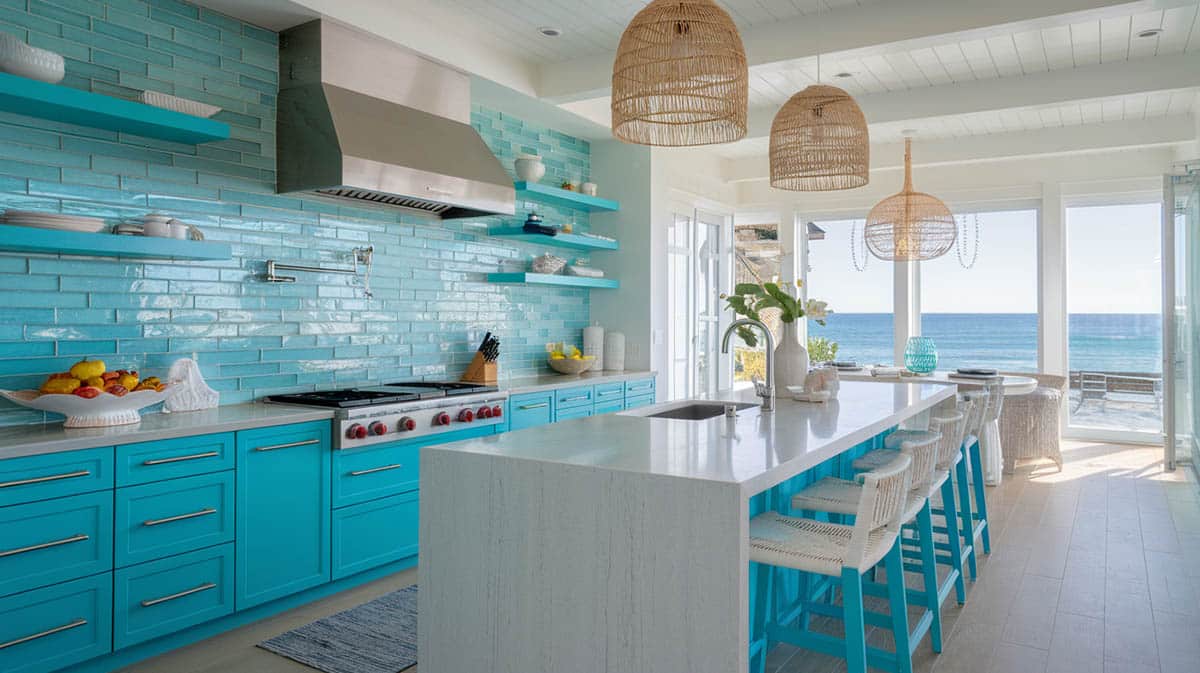
Coastal – Turquoise cabinetry brings the vibrancy of tropical ocean waves right into your home. Pair the cabinets with crisp whites, sandy beiges, and soft grays to create a sophisticated coastal palette that echoes ocean and beach tones. Complementing this bold color choice with the right decor completes a cohesive coastal kitchen design. The breezy simplicity of contemporary beach styling allows the gemstone hue of the cabinets to shine as the focal point.
Crisp white cabinets and quartz countertops to keep the look light and airy. Go for sleek lines rather than ornate details. Brushed nickel or chrome hardware adds a hint of shine without competing with the dynamic cabinets. Ty to incorporate natural textures that evoke thoughts of sea and sand to accentuate the oceanic color palette. Glass tile backsplashes with organic shapes, wood elements, and woven accents help reinforce the coastal vibe.
Mid-Century Modern – For a mid-century vibe, pair your turquoise cabinets with clean-lined maple doors and drawers devoid of ornamentation. You can consider complementing the color with warm walnut woods, bright whites, and mustard yellow accents to achieve an authentic mid-century aesthetic while maintaining a modern appeal.
Metallic accents like brass hardware and pendant lights add warmth and contrast. Black and white graphic prints and patterns, especially on tile backsplashes or flooring, reinforce the geometric theme. Walnut wood introduces natural texture while terrazzo or concrete countertops echo the color story in a more solid form.
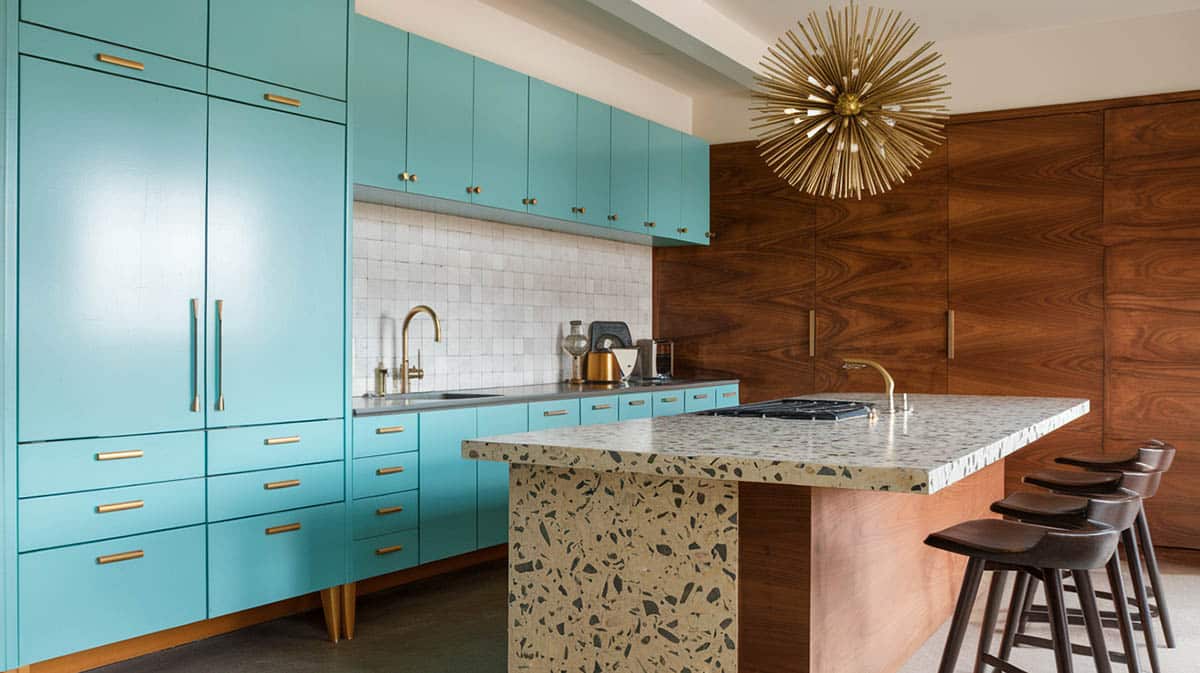
Or take your turquoise cabinets in a softer pastel direction with painted shaker-style frames and a buttery yellow island for sweet pops of contrast. White open shelving, farmhouse sinks, and vintage-look appliances balance the dreamy, airy aesthetic with plenty of breathing room.
Bohemian – Since this aqua color makes such a bold statement, embracing their vibrancy in a bohemian modern design creates an eclectic yet cohesive style. The key is balancing the eye-catching hue with other elements that provide depth and dimension.
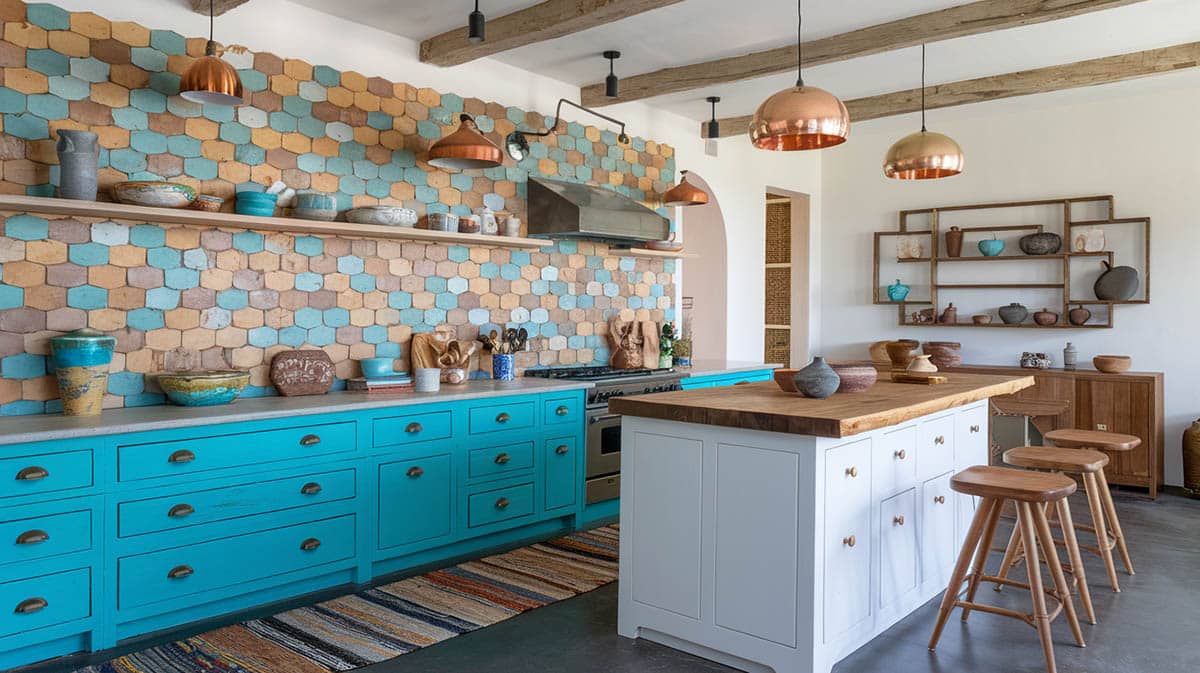
Mixing metallic finishes brings out the shine in the turquoise while introducing contrast. Aged bronze hardware against brushed nickel lamps adds visual interest. Handmade cement tile backsplashes with organic shapes provide texture. Natural wood shelves and countertops warm up the look. Wrought iron light fixtures and pendant lights complement the artisanal style.
By thoughtfully selecting materials with natural patterns, you can enhance the dazzling color of the cabinets. Rough wood grains, irregular stone surfaces, and handcrafted tiles prevent the space from feeling too sleek or uniform.
Industrial – Going for an industrial modern vibe in your kitchen? Then you’ve likely got your sights set on a bold splash of turquoise for your cabinets. This vibrant blue-green hue lends itself perfectly to the utilitarian chic style. The key is to complement the standout color with industrial accents that feel cohesive yet unique. Contrast the hue with charcoal grays, raw steel finishes, and matte blacks to maintain industrial authenticity while adding a contemporary tone.
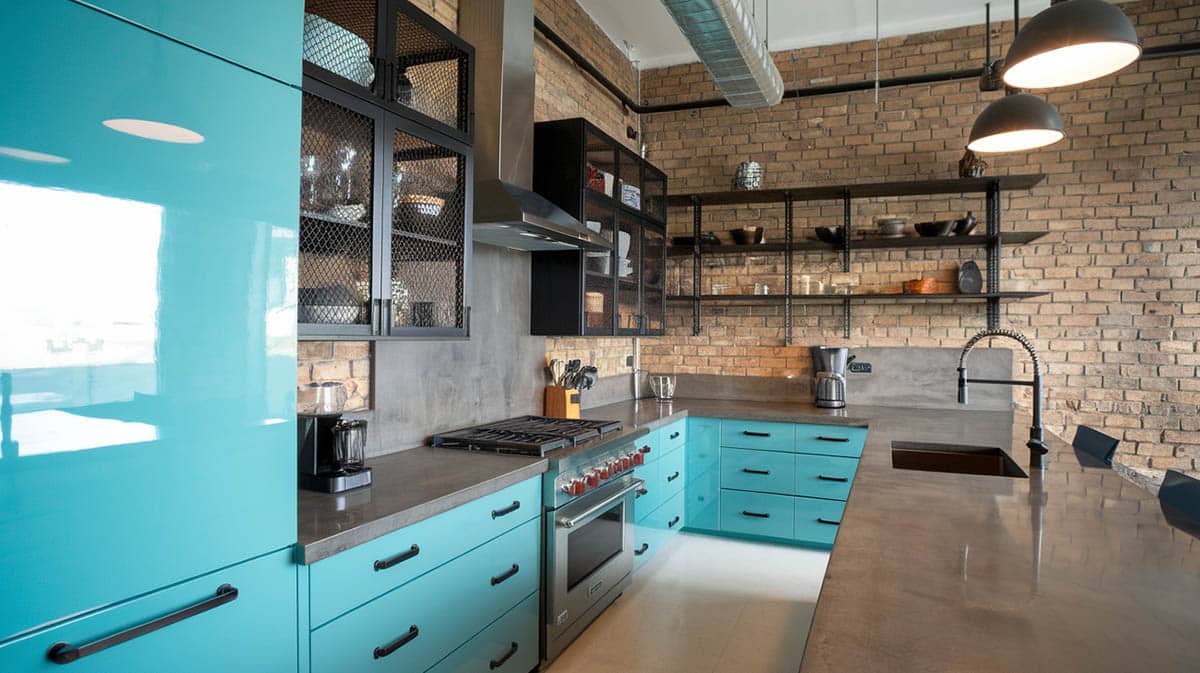
When it comes to color coordination, overall, I’d say the turquoise and raw steel combo nails that perfect balance of vibrant color, industrial edge, and authenticity. To get a stylish two-toned look, use the turquoise as the dominant shade on 60% of cabinets, the steel tone on 30% as a secondary player, and add just 10% black for depth. Incorporate mixed metal hardware, clean lines, and minimal ornamentation for best results.
Exposed pipes and ductwork lend a raw, unfinished look. Metallic finishes on fixtures and hardware also epitomize industrial style. Opt for matte black for a bolder contrast or brushed steel for more sheen. Concrete countertops complement the rugged warehouse aesthetic beautifully. The gray tone works nicely with the turquoise while the rough texture provides interest.
In terms of cabinetry style, aim for a minimalist, functional design. Simple slab fronts with as little ornamentation as possible keep the look modern. Then make use of open shelves sparingly to display favorite cookbooks and wares.
Scandinavian – The clean whites and light woods of the Scandinavian modern style create a bright, airy feel perfect for showing off a bold turquoise on kitchen cabinets. The crisp color pops against the neutral backdrop, becoming a functional and stylish focal point. Resist over accessorizing your bright color cabinets and pair with light blonde woods, pure whites, and pale grays to create a serene, Nordic-inspired palette.
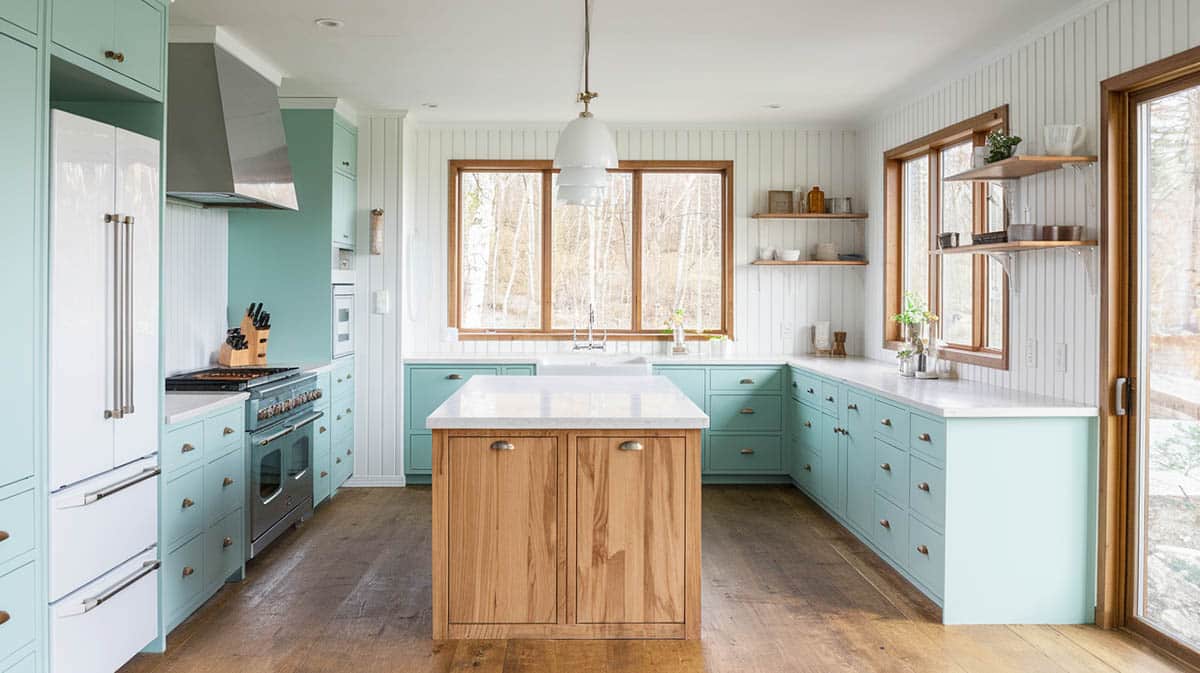
Keep hardware minimal and focused. For example, brushed nickel pulls maintain modern sensibilities without competing against the vibrant hue. Sophisticated lines and plenty of natural light keep the style fresh and inviting. Surround turquoise with light wood elements to create a coordinated elegance that goes with the style. The inherent coziness of Scandinavian design gracefully balances the cabinets’ saturated color. White countertops also highlight their beautiful blue-green tones. The combination feels both exciting and serene.
Highlights Of The Design Styles:
Coastal Contemporary: Emphasizes nautical elements
Mid-Century Modern: Features geometric patterns
Bohemian Modern: Embraces eclectic details
Industrial Modern: Highlights raw materials
Scandinavian Modern: Focuses on minimalism
Art Deco Modern: Showcases glamorous elements
Backsplash Selection Tips
Choosing the perfect backsplash is an important decision that can make or break your kitchen design. When working with striking turquoise cabinets, you’ll want a backsplash that enhances their vibrancy without overpowering the space. Natural stone often pairs beautifully for a high-end look. For a classic aesthetic, try slabs of White Carrara marble with soft gray veining. Feeling a little bolder? Go for the warmth of Calacatta Gold marble and its snaking golden streaks. Prefer an elegant, pure contrast? Thassos White marble has you covered.
When installing, consider going full-height for a dramatically luxe appearance. Or, apply marble just between the countertops and cabinets for a more cohesive flow. Another option is to do decorative insets around focal areas like the range or sink. If your style is more modern, give tile a go. Geometric layouts add movement and interest to any turquoise kitchen. The sophistication of a herringbone pattern, the clean lines of stacked tile, or the old-world charm of a basketweave – all make excellent choices. Stay timeless with white tiles or kick it up a luxurious notch with mixed metallics. If you want to reflect the playfulness of your aqua-toned cabinets, opt for a tile with a fun pattern or design.
Choosing Countertops To Use
With the vibrant cabinetry as the focal point, you have an opportunity to choose a countertop surface that contrasts beautifully or echoes the tones. Drama awaits with stark options like pure white quartz or absolute black granite – either would make the turquoise pop. For a more integrated look, consider quartz with natural veining in grey and taupe or a salt and pepper granite with flecks that pick up the cabinetry color. Speckled quartz or white galaxy granite can add visual texture and sparkle.
Beyond stone, alternative countertop materials offer distinct styles. Butcher block wood brings natural warmth. Sustainable bamboo makes an eco-friendly statement. Reclaimed wood topped with a clear coat adds rustic character. For an ultra modern look, opt for polished concrete alone or with a concrete sink seamlessly molded into the countertop. With concrete, you can even customize the pigment to coordinate with the turquoise.
Material Selection:
- White quartz for a crisp contrast
- Butcher block to add warmth
- Dark granite for extra drama
What Hardware Works Best?
Carefully choose the metals and hardware styles to create a cohesive look by using warm metal finishes like brushed brass, antique gold, and copper that pair excellently with the blue-green hue. These can add add a touch of sophistication, vintage appeal, or rich contrast depending on the style you choose. Cool metal finishes can also complement the turquoise beautifully. Go for refined polish with nickel, contemporary shine with chrome, or durable stainless steel.
The hardware shapes and styling should align with the overall kitchen aesthetic you want. For a sleek contemporary kitchen, opt for linear pulls in consistent lengths, minimal knobs, or hidden pulls to maintain the clean lines. If aiming for a more traditional style, consider cup pulls for some classic appeal, decorative knobs to inject visual interest, or even mixing hardware styles together for depth.
Finish Selections:
- Brushed metals for a casual feel
- Polished metals for a formal look
- Mixed metals for an eclectic design
By adapting to existing architecture and light, while respecting turquoise’s vibrant spirit through complementary accents, an enduring kitchen emerges – professionally sophisticated, and matching, yet warmly livable. Thoughtfully balancing the bold and refined elements can create a memorable, and also comfortable space perfect for gathering and celebrating. Do you use this color in your kitchen our are considering it? Share your comments below to let us know what you think.

